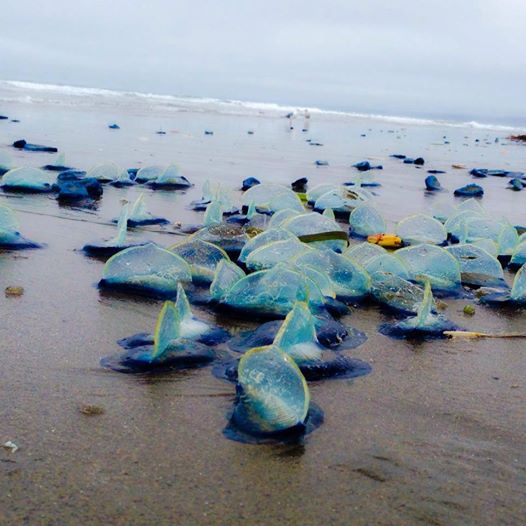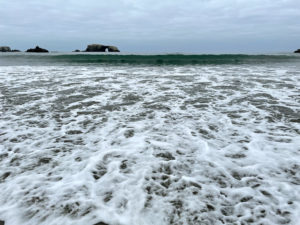Recently, Bay Area beachcombers have been spotting hundreds of mysterious blue jelly-like creatures littering area beaches. What are they, and why are they here? Bay Nature naturalist Michael Ellis explains in this column recalling a similar beaching he witnessed in 1991:
“Yech! Look at these mussel guts!”
“There are tons of dead jellyfish.”
“Phew, it stinks here.”
“Hey, what are these things anyway?”
These are just a few of the comments I heard this past Sunday at Shell Beach, just off the Sonoma coast as we poked through debris left by the last high tide. Floating offshore were many more of the mysterious animal wafers, heading to their doom.
Every spring and summer, millions of these intriguing critters wash ashore and die along the western coast of North America. The limp, soggy pieces of blue protoplasm elicit more curiosity than any other bit of flotsam along the California coast. Last month the beaches along the entire Central Coast received one of the first shipments of Velella velella. An oil slick reported off of Santa Cruz proved to be acres and acres of floating Velellas. Beaches are now littered with their bodies.
The animal is easy to identify. It averages two inches across its flattened oval body and has a prominent sail. This flexible, triangular projection catches the wind and can move the animal quickly along the water even in a gentle zephyr. It is this remarkable ability that inspired early mariners to christen it the “By-the-wind Sailor.”
Velella is in the same phylum as anemones, corals, jellyfish and hydroids. It was once thought to be a colony of animals similar to the infamous Portuguese Man-of-War, but careful research has shown that it is a complicated individual rather than an assemblage of animals. Its central mouth is surrounded by feeding tentacles and reproductive polyps. The gas-filled body is topped by the transparent sail.
Even though Velellas are very common and distributed throughout the oceans of the world, very little is known about the details of their life. The reproductive polyps apparently bud off small medusae (miniature jellyfish-like structures) somewhere in the middle of the ocean. The medusae sink to depths of over 7,000 feet and grow gonads which produce sperm or eggs. Fertilization occurs in the dark abyss. The small young develop a float, secrete gas into it and rise slowly thousands of feet to the surface. Here they glide along feeding on animal plankton that they sting with specialized cells (located on the tentacles) called nematocysts.
Drifting and growing, drifting and growing, Velella floats along without a care in the world. Well, not quite. There are two predators. A ocean-going sea slug and a bubble-crafting snail also cruise the ocean eating all the By-the-Wind Sailors they accidentally encounter.
There are two forms of Velella. California specimens have a sail which is angled to the right of the main axis. This means that as the wind pushes it along, Velella tacks as much as 60 degrees to the right of the true wind direction. Our predominant wind is from the northwest, therefore these animals are usually kept offshore. However occasionally there is a southwesterly wind which drives millions to certain death. Our recent storms have also brought Velellas to our beaches.
The other form of Velella has a sail angled to the left of the main axis. Not surprisingly these animals are found on the other side of the ocean — Japan, Korea, and Siberia. Here the sail functions in the same way: it keeps the animal offshore — safe and growing.
The population is evenly split between the right and left-handed Velellas. It is not clear whether the righties only beget righties and lefties lefties or whether each type produces both. You may add that to your list of riddles to ponder as you wade through the dried up cellophane bodies of this common but remarkable animal.
Naturalist and adventure travel guide Michael Ellis writes Bay Nature’s Ask the Naturalist column. Find his work in every issue of Bay Nature magazine!





